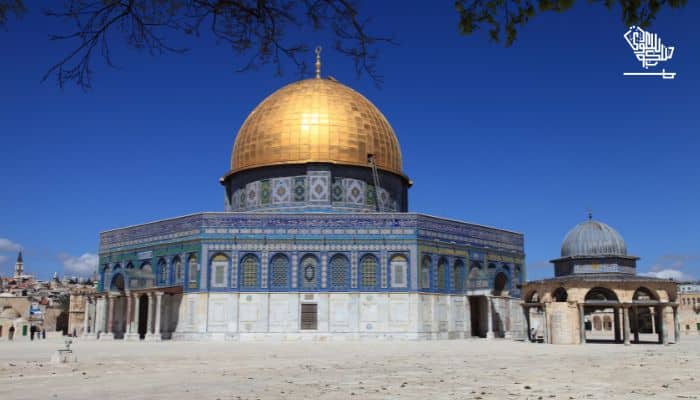Discover seven fascinating things about Masjid Al-Aqsa you probably didn’t know—a place of immense religious significance for many.
A bit about Masjid Al Aqsa
Masjid Al-Aqsa, located in the Old City of Jerusalem, is the third holiest site in Islam after Masjid Al Haram and Masjid Nabawi.
The Mosque has many names, like Farthest Mosque, Baitul Muqadis, Qibli Mosque, or Qibli Chapel. It was established in the 7th—8th century and occupies 144,000 square meters with a capacity of 5,000+ people.
Muslims worldwide have a special place in their heart for the holy site, but these are a few things you probably didn’t know about Masjid Al Aqsa!
Masjid Al Aqsa is not just one Mosque
When we talk about Masjid Al Aqsa, many people imagine it as a single mosque. However, the truth is that Masjid Al Aqsa is more than just one Mosque. It consists of several mosques within its compound.
The commonly known Masjid Al Aqsa, which we often refer to, is the “Qibli Mosque” at the southernmost corner. It earned this name because it is believed to be closest to the Qibla.
The entire Mount or the compound, known as the Noble Sanctuary and commonly referred to as Masjid Al Aqsa, is also called Al-Haram ash-Sharif to avoid any confusion.
Other mosques, such as the Buraq Mosque and the Marwani Mosque, are located within the Mount or the compound of Masjid Al Aqsa. These mosques derived their names from significant historical events.
Initial Qibla from Muslims
The universally recognized practice among Muslims is to perform their prayers facing the Holy Kaaba, also known as the Ka’ba al-Musharraf, in Mecca. However, this was not always the case.
Masjid Al Aqsa is Muslims’ initial Qibla (direction of prayer) before turning towards the Kaaba.
But before this change of Qibla (direction of prayer), the Muslim Ummah used to pray in the direction of the Noble Sanctuary in Jerusalem. That’s why it is also known as the Qibli Mosque because of its historical significance and since it’s closest to the Qibla.
Allah SWT later instructed Prophet Muhammad (PBUH) through Surat Al-Baqara to change the direction of the Qiblah towards Kaab in the Holy City of Mecca.
The History of the Golden Dome
When you think of Masjid Al Aqsa, the image of its iconic shining golden Dome often comes to mind. But, the Mosque didn’t look how it does now. It was pretty different in its early days.
The foundations of Al-Aqsa Mosque are believed to have been laid approximately 40 years after the construction of the Grand Mosque. Khalifah Umayyah Abdul Malik ibn Marwan, a renowned Umayyad leader, constructed it.
The Dome of the Rock, an iconic structure within the complex of Masjid Al Aqsa, had an exciting evolution in its construction. Initially, it was built using wood, adorned with lead or brass, and then covered with ceramic.
Later, during the Ottoman Era, Sultan Suleiman the Magnificent ordered the addition of a distinctive golden layer to the top of the Dome and the placement of Ottoman tiles around the building, giving the Dome its current appearance.
The Legendary Minbar of Masjid Al Aqsa
Imad ad-Din Zengi, a member of the Turkish Zengid dynasty, planned to construct a special minbar in Masjid Al Aqsa.
A minbar is a pulpit or elevated platform in a mosque where the imam stands to deliver sermons or speeches. It is especially significant in Islamic worship.
Aside from being beautiful, this Minbar’s remarkable fact is that it was built without using nails or glue.
Unfortunately, Imad ad-Din Zengi passed away before witnessing his creation and vision come to life. His student, Salahuddin, fulfilled the dream after liberating Jerusalem for the second time in Islamic history. It is also known as the Minbar of Saladin.
Sadly, the Minbar was destroyed and did not survive the events of 1967 when the Israeli troops burnt down Masjid Al Aqsa, and the wood was shattered into pieces.
A Temple Mount for Jews
Masjid Al Aqsa is built inside an area known to Muslims as Al-Haram al-Sharif but in Hebrew, and the compound is called “Har HaBayit,” commonly known as Temple Mount.
Traditionally, the Temple Mount is believed to be where Abraham showcased his unwavering devotion to God.
This 14-hectare (35-acre) rectangular compound was captured by Israel during the 1967 Six-Day War, destroying the Minbar.
During the Six-Day War, Israel also seized the rest of East Jerusalem and subsequently annexed this territory, but it has not yet been recognized internationally.
From Garbage Dump to Sacred Ground
This is a lesser-known fact, but the area now known as Masjid Al Aqsa or Temple Mount was once a garbage dumping ground.
This was during a time when Jews were prohibited from living in the city, and the space was occupied solely by Romans, who used it as a dump site for their waste.
However, everything changed when Hazrat Umar Farooq (RA) liberated the city. With his bare hands, he cleared the trash from the dump area.
In doing so, he not only transformed the physical state of the area but also ended the centuries-old war. He invited approximately 70 Jewish families back into Jerusalem, granting them the right to return after centuries of exile.
Palace, Chapel, and Execution Chamber
A shocking fact about Masjid Al Aqsa is its dark history of being used as a palace, chapel, and execution chamber.
When the first Crusaders arrived in Jerusalem, they discovered that a large number of the city’s Muslim population was locked up in Masjid Al Aqsa.
Tragically, approximately 70,000 Muslims were mercilessly slaughtered on the Mosque’s grounds during the initial executions.
Surviving Muslims faced a gruesome fate as well. They were crucified on a cross positioned near the center of the compound. Salahuddin Ayyubi later broke down the cross.
During that time, the Qibly Masjid was turned into a palace, the Dome of the Rock into a chapel, and the underground chambers into a stable.

As a native to books and novels all through my childhood, I draw inspiration from fiction, anime, fashion, and philosophy in my writing. My stories aim to transport readers to extraordinary realms, blending thought-provoking ideas with imaginative storytelling. With my pen as a magic wand, I weave narratives that blur reality, inviting readers to get lost in my creative universe.




